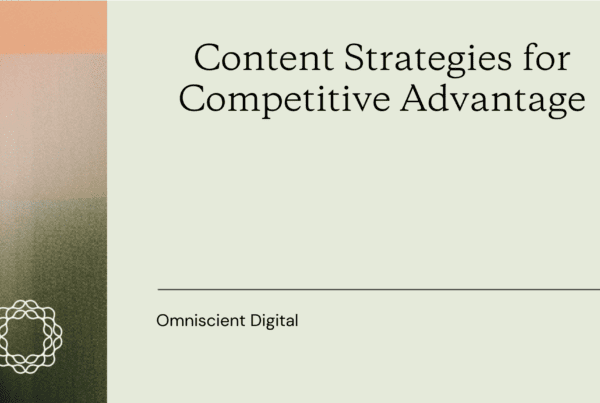
Economics is a useful framework for content marketing because as a business investment, ROI is always top-of-mind.
Just as in other industries with other goods and services, content marketing can be mapped out using economic tools like supply and demand curves.
In industries with few competitors, it might be easy to supersede the competition and rank for valuable keywords, and therefore not need to spend as much money to see a return on your investment.
In crowded industries, however, you may have to pay a premium for high quality content that will generate results … especially if you’re a new player with a low domain rating.
Similarly, if, in a given niche, the supply of writers is low but the demand for content is high, the price of high quality content will be high and needs to be factored into your plan.
We’ll dig into the different economic concepts at play in content marketing strategies.
The cost of content
The cost of creating content comes down to three things:
- The level of difficulty to produce the content
- The level of content competition
- Your website authority
1. The type of content ultimately determines the cost
Listicles and roundup posts (a collection of quotes or statistics) are “cheap” because they’re formulaic and easy to produce, meaning the barrier to production is low and pretty much anyone can produce an article of sufficient quality.
On the other hand, it’s more “expensive” to conduct an original research study. You’d need a good writer, a researcher, an outreach specialist, a sample population to study, and a lot of time.
This type of content is more expensive, difficult to produce, and harder to replicate which is why you don’t see as many original research studies as you do listicles.
Notice that when we talk about “cost,” we aren’t just considering the dollar amount—this also includes the time and resources required to produce the content. In the case of a research study, that also considers the years of industry experience required to turn a nuanced idea into a thoughtful piece of content.

2. Competition determines what type of content to produce
The level of competition in terms of the number of competitors often determines the cost of content because it determines the type of content you need to create to stand out.
If there are few competitors and the barrier to entry is low, businesses will likely do the minimum to meet that bar (i.e. they’ll write listicles) until another business produces higher quality content and raises the bar.
If there is more competition and the content in the industry has matured, you might see a handful of businesses that rank for many keywords or a lot of businesses that target the same keywords. In this case, the barrier to entry is high, and to stand out, you will need to create content that is high quality and difficult to replicate.

3. Website authority determines how you will compete
If you’re a new business with little website authority (we use Domain Rating from Ahrefs as a measurement of website authority, you can also use free options like Small SEO Tools or SEO Review Tools), you will likely compete with existing businesses with more website authority. This will make it difficult for you to capture your target keyword and rank on the first page of the search results.
If there’s a lot of competition and content in the industry, you’ll need to create more “expensive” content to stand out.
If you’re an existing business with high website authority, it’ll be easier for you to build a “content flywheel” (more on this later), meaning you will have an easier time ranking for keywords. Even if your content isn’t of the highest quality or the most in-depth, your high website authority will help you rank and capture that search traffic.
We’ll dive into this in the next section.
What content should you create?
The ultimate goal is to produce content at the lowest possible cost that will generate the highest possible return.
When your blog and website are new, “cheap” content won’t be effective because the competition of cheap content from websites with higher website authority than yours, means your cheap content won’t rank in the search engine results.
This means you need to write “expensive” content—content that is excellent or unique—to stand out, rank, and generate backlinks to build up your website authority.
As your website authority grows, you can increase the frequency of your publication and lower the quality bar (though, hopefully you aren’t completely sacrificing quality).
The easiest way to explain this is with the table below:
| Domain Authority | Industry Competition | Content to Produce |
| Low (0-30) | Low | Cheap |
| Low (0-30) | Moderate | Expensive |
| Low (0-30) | High | Expensive |
| Moderate (31-70) | Low | Cheap |
| Moderate (31-70) | Moderate | Expensive |
| Moderate (31-70) | High | Expensive |
| High (71-100) | Low | Cheap |
| High (71-100) | Moderate | Cheap |
| High (71-100) | High | Cheap |
The paradox here is that new businesses and websites who probably have the least time and resources need to spend the most on each piece of content to make their content program successful.
The decision around what type of content to create comes down to which tradeoffs you’re willing to take.
For example: If your website has little authority and you’re facing a lot of established competitors, you might have two options:
- Spend time and resources producing 10 “cheap” listicles knowing they have little chance of ranking but knowing you produced content.
- Spend those same resources on 1 unique comprehensive research study that is more likely to capture interest and backlinks, and thus more likely to rank.
When looking at those options, it’s a tradeoff between:
- Short- versus long-term: We published 10 blog posts in 10 weeks or we published 1 research study in 10 weeks.
- Fluff versus results: We published 10 blog posts so the blog has content versus we published a research study that generated leads.
- Outputs versus outcome: We published 10 blog posts that don’t bring in traffic versus we published a research study that captured our target keyword and brought in two customers.
Fortunately, the tradeoffs change and become significantly easier as your website develops more authority.
As your website develops more authority, it becomes easier to publish content that will capture your target keyword and rank on the first page of the search results. This is what we call a “content flywheel.”
Large brands and established blogs that have developed a “content flywheel” can often publish low-quality content and listicles targeting competitive keywords and still rank on page one of the search results.
Start blogging now, write amazing content, have patience, and you’ll eventually be able to rank for almost anything.
The business case for cheap content
In business, we try to maximize the delta between the cost of an investment and the return it generates. We want to be able to invest $1 and have it generate more than $1 in return.
If we can produce a cheap piece of content that gets the same or better results than an expensive one, why would we waste the resources on an expensive one? That would be bad business.
Here’s an example: Product listicles perform super well for HubSpot. These articles bring in a lot of traffic, generate conversions in the form of leads and product signups (what we refer to as Product Led Content), and are easy to produce.
We’d be remiss if we didn’t mention the “hidden cost” of this content. HubSpot has invested in content since 2006, and thus their website has a lot of authority (at the time of writing this post, HubSpot.com has a domain rating of 92!).
What we see now is the return on investment from all the years of producing content.
Content becomes vital to the business when you can get your content to rank high in the search results. Once you build your content flywheel, you can generate business returns while producing lower quality content.
At that point, you can create templated content and scale up your production.
But in order to get to that point, you might need to do the things that don’t scale (creating expensive, amazing content) to compete on quality or differentiation.

There’s no set point or clear milestone of when you can start to easily rank with “cheaper” content, but there’s an inflection point. In our experience it looks a bit like this:

Notice the quality bar never drops to zero. That’s because in the future, we’d expect Google’s algorithm to get smarter at detecting the quality of content so producing great content will be a hedge against future uncertainty.
As a bonus, good content builds good brands. People read CXL and WaitButWhy because the content is excellent.
From working at a few content-heavy companies (HubSpot and CXL) and creating content for many clients, we’ve learned that detecting where your content and website stand relative to your competitors requires the following:
- Analyze the competition and make assumptions on the feasibility to rank.
- Build a growth model based on those assumptions.
- Publish content and build backlinks to it and see where you typically land in the search results.
- Compare where you landed versus where you thought you would and adjust your model.
Here are some very tentative rules of thumb we use when working with clients.
Let’s assume you produce a 2,000 word article (high quality, of course) which costs about $500 to produce. Depending on your domain rating, here are some probable rankings to expect and the action we recommend you take to increase your rankings:
| Domain Rating | # of Posts on First Page | Action Needed |
| 0-20 | 1 of 10 | Targeted link building |
| 20-40 | 2 of 10 | Targeted link building |
| 40-60 | 3-4 of 10 | Some targeted link building |
| 60-80 | 5-6 of 10 | Little to no targeted link building |
| 80-100 | 8-9 of 10 | No targeted link building |
When we say “targeted” link building, we mean manually building links to that specific blog post, not general links to your domain or to other blog posts, and not links obtained organically.
These rules of thumbs are estimates and depend on your industry, competition, content quality, and keyword difficulty (a metric used by SEO tools to estimate the likelihood you’ll be able to rank for the keyword).

As you can see, there’s a lot of uncertainty when it comes to predicting the output and return on investment of content marketing–this is especially true in the early stages of your content program. But that doesn’t mean you shouldn’t try to understand the potential upside of content.
Start creating your content flywheel now
Cheap content is economically smart for businesses to create but only works after investing time and effort into building a content flywheel.
Start with noteworthy, remarkable, “expensive” content to break through the noise. Then once you’ve increased your website authority, you can begin to publish templatized content that’s cheaper to produce to start generating more return on investment.



